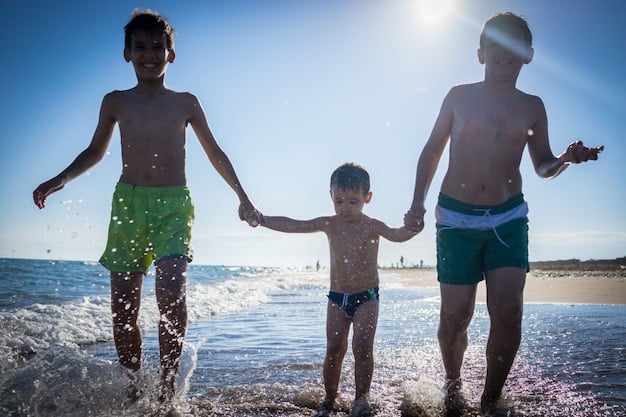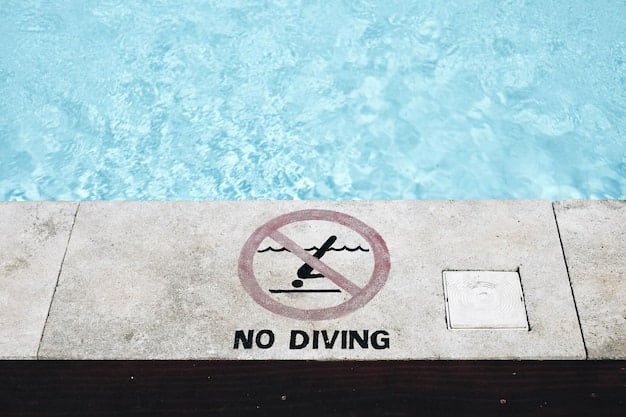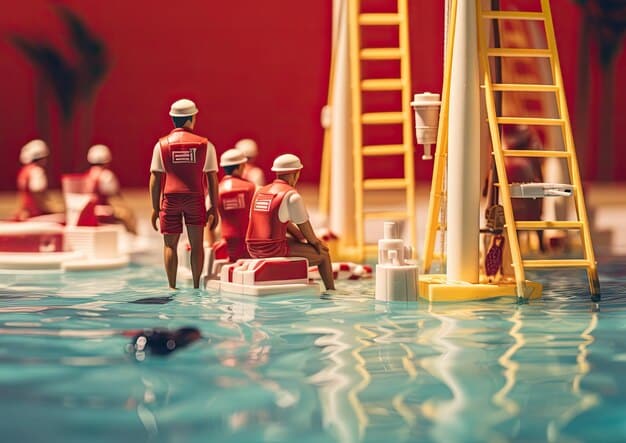Water Safety: Essential Tips to Prevent Drowning & Injuries

Water safety is paramount to preventing drowning and water-related injuries, involving education, awareness, and proactive measures to ensure safe aquatic activities for everyone.
Enjoying water activities safely requires knowledge and vigilance. This guide provides essential water safety tips to prevent drowning and water-related injuries, ensuring a safer experience for you and your loved ones.
Understanding the Risks: Drowning and Water Injuries
Water safety begins with acknowledging the potential dangers. Drowning is a leading cause of accidental death, while water-related injuries can range from minor cuts to severe trauma. Understanding these risks is the first step toward prevention.
Common Drowning Scenarios
Drowning incidents often occur in unexpected situations. Recognizing these scenarios can help you stay vigilant and take preventive measures.
- Lack of Supervision: Children left unattended near water.
- Inadequate Swimming Skills: Individuals overestimate their abilities.
- Hazardous Environments: Unprotected pools, open water with currents.
Types of Water-Related Injuries
Beyond drowning, various injuries can occur in and around water. Being aware of these can prompt you to take precautions.
- Slip and Fall Injuries: Wet surfaces causing accidents.
- Diving Injuries: Spinal cord damage from shallow dives.
- Boating Accidents: Collisions leading to injuries.

By understanding these risks, you can create a safer environment for yourself and others, reducing the likelihood of accidents and promoting responsible behavior around water.
Essential Swimming Skills and Training
One of the most effective ways to enhance water safety is by acquiring and improving swimming skills. Proper swimming training can significantly reduce the risk of drowning and increase confidence in the water.
Enroll in Swimming Lessons
Swimming lessons are crucial for both children and adults. A structured program can teach essential skills and build confidence in the water.
- Basic Water Skills: Floating, treading water, and basic strokes.
- Advanced Techniques: Efficient swimming strokes for various scenarios.
- Water Rescue Skills: Techniques to assist others in distress.
Importance of Continuous Improvement
Swimming skills should be continuously improved and practiced. Regular swimming sessions can help maintain and enhance these skills.
- Regular Practice: Frequent swimming to reinforce techniques.
- Advanced Training: Lifeguard certification for advanced skills.
- Staying Updated: Keeping up with the latest water safety guidelines.
Investing in swimming education can provide a lifetime of safe and enjoyable experiences in the water. It empowers individuals to respond effectively in emergency situations and promotes a culture of water safety.
Supervision and Lifeguard Awareness
Vigilant supervision is crucial in preventing drowning incidents, especially among children. Being aware of lifeguard roles and responsibilities can also contribute significantly to water safety.
The Importance of Constant Supervision
Constant supervision means keeping a close eye on individuals in and around water. This is especially important for young children and inexperienced swimmers.
- Designated Supervisor: Assigning someone to watch the water.
- Proximity: Staying within arm’s reach of young children.
- Undivided Attention: Avoiding distractions like phones or conversations.
Responsibilities of Lifeguards
Lifeguards are trained professionals responsible for ensuring safety in aquatic environments. Understanding their role can help you cooperate and stay safe.
- Surveillance: Monitoring the water for signs of distress.
- Intervention: Responding to emergencies and providing assistance.
- Enforcement: Enforcing rules to maintain safety.

By practicing vigilant supervision and respecting the role of lifeguards, you can create a safer environment for everyone and minimize the risk of drowning and other water-related incidents.
Creating a Safe Aquatic Environment
A safe aquatic environment involves various measures to prevent accidents and promote responsible behavior. These measures include proper fencing, signage, and adherence to safety guidelines.
Implementing Safety Measures in Pools
Pool safety measures are essential for private and public pools. They help prevent unauthorized access and reduce the risk of accidents.
- Fencing: Installing a fence around the pool area.
- Alarms: Using pool alarms to detect unauthorized entry.
- Coverings: Employing pool covers when not in use.
Adhering to Safety Guidelines in Open Water
Open water environments require specific safety measures due to their unpredictable nature. These include awareness of currents, weather conditions, and proper safety gear.
- Weather Monitoring: Checking weather forecasts before engaging in water activities.
- Current Awareness: Understanding potential currents and tides.
- Safety Gear: Using life jackets and other safety equipment.
Creating a safe aquatic environment involves a combination of physical measures and responsible behavior. By implementing these strategies, you can minimize risks and promote enjoyable experiences.
Essential Equipment and Gear for Water Safety
Having the right equipment and gear is crucial for enhancing water safety during aquatic activities. This includes life jackets, flotation devices, and first aid kits.
Importance of Life Jackets and Personal Flotation Devices (PFDs)
Life jackets and PFDs are essential for swimmers of all skill levels. They provide buoyancy and can prevent drowning in emergency situations.
- Proper Fit: Ensuring life jackets fit snugly and securely.
- Appropriate Type: Selecting the right type of PFD for the activity.
- Regular Inspection: Checking life jackets for damage and wear.
First Aid Kits and Emergency Supplies
Having a well-stocked first aid kit is crucial for addressing minor injuries and providing immediate care in emergency situations.
- Basic Supplies: Bandages, antiseptic wipes, and pain relievers.
- Emergency Contacts: List of emergency phone numbers.
- CPR Certification: Knowledge of CPR and basic first aid techniques.
Equipping yourself with the right gear and supplies can make a significant difference in ensuring water safety. It allows you to respond effectively to emergencies and provide immediate assistance when needed.
Educating Children and Promoting Water Safety Awareness
Educating children about water safety and promoting awareness are vital steps in preventing drowning and water-related injuries. This involves teaching them about risks, rules, and responsible behavior around water.
Teaching Children About Water Safety
Educating children about water safety should start at a young age. This includes teaching them about the dangers of water and the importance of following rules.
- Basic Rules: No running near the pool, no diving in shallow water.
- Safe Practices: Always swim with a buddy, never swim alone.
- Emergency Response: Teach them how to call for help.
Promoting Community Awareness Through Campaigns
Community awareness campaigns can help promote water safety and educate the public about risks and preventive measures. These campaigns can involve various activities and initiatives.
- Educational Workshops: Organizing workshops on water safety.
- Public Service Announcements: Creating and distributing announcements.
- Community Events: Hosting events to raise awareness.
| Key Point | Brief Description |
|---|---|
| 🏊 Swimming Skills | Enroll in lessons for basic and advanced techniques. |
| 👀 Supervision | Always keep a close watch, especially on children. |
| 🦺 Safety Gear | Use life jackets and maintain a first aid kit. |
| 🚨 Environment Safety | Secure pools with fences and follow open water guidelines. |
Frequently Asked Questions About Water Safety
▼
The most important rules include no running, no diving in shallow areas, and always swimming with a buddy. Never swim alone, and ensure constant supervision.
▼
Enroll in swimming lessons to learn basic techniques and improve your strokes. Regular practice is key to maintaining and enhancing your swimming skills. Stay updated.
▼
Include bandages, antiseptic wipes, pain relievers, and a list of emergency phone numbers. Knowledge of CPR is also very helpful to the injured person.
▼
Ensure the life jacket fits snugly and is appropriate for the type of activity you are participating in. Inspect it regularly for damage.
▼
Open water involves currents, tides, and unpredictable weather, requiring more caution. Pools are more controlled, but can still be dangerous. Therefore awareness must always be present!
Conclusion
Remaining vigilant, educating oneself and others, and using proper safety measures and equipment can all contribute to a safer and more enjoyable aquatic experience. These steps can help prevent accidents and promote responsible behavior in and around water.





